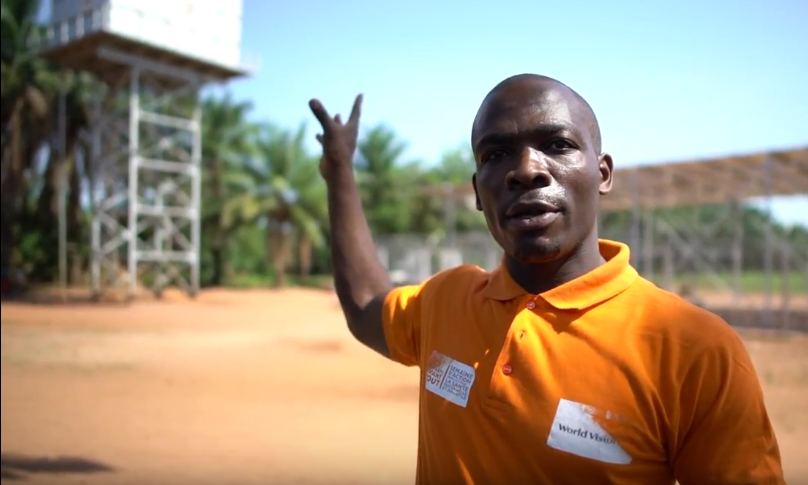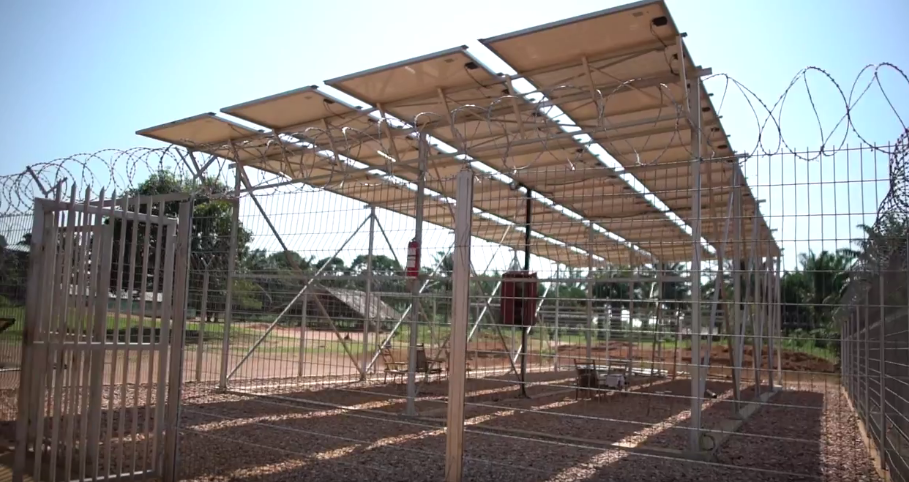Bernadette and her husband, Serge Jackson, can watch their children grow up healthy thanks to a nearby kiosk supplying clean water from a deep water well system. In a remote area of DR Congo where clean water used to be rare, their family now only needs to walk a few minutes for safe drinking water–a story previously told on the CKC blog.
This clean water access became a reality through Covenant Kids Congo, a strategic partnership between The Evangelical Covenant Church, World Vision, and local Congolese churches like the Covenant Church of Congo (CEUM). Through this partnership and the hard construction and maintenance work of the Congolese people, two deep water well systems have been implemented, and a third one will be on the way later this year.
In the city of Gemena located in northwest Congo, two deep borehole wells have been drilled. Between these wells and local capped springs, a total of 24,000 people now receive clean and accessible water. How does a system of such a scale work? And what does it take to maintain and sustain it?
How a Deep Water Well System Works
During the most recent visit, a World Vision technician named Franck answered these questions and more in an interview with CKC travelers at the area where a deep water well was drilled. Each well system incorporates a water tower, a solar-powered pumping station, and multiple water kiosks and distribution points.
Through a translator, Franck explained that each deep well exceeds depths of 65 meters (215 feet) below ground. Near the bottom of a well, submersible pumps powered by solar energy propel water upwards, to be stored in the elevated water tower tanks. As Franck spoke, the system could be seen behind him on a sunny day in Congo.

Franck motions to the drilled well and water tower tank on the left. The solar panel structure can be seen behind him and to the right.
“When there’s sun, the water is automatically pumped from the well up into the tank,” Franck said. “When the tank is full, there’s an automatic shutoff system so there’s not overflow. There’s a valve over there that opens water to distribute to water kiosks.”
A controller manages and measures the power, enabling the pump to fill the 100-cubic meter (26,000-gallon) tank in just five hours on a sunny day.
|||||||||||||||||||
Pumping Water for the Whole Neighborhood
The CKC team stopped to view a counter under the water tower tank. Similar to one typically installed in a U.S. home, the counter had recorded the cumulative volume of water processed since the system first started functioning. So far, nearly 7,000 cubic meters (2 million gallons) of water had been processed–which was enough to fill the tank pictured above 67 times!
Each kiosk that receives distributed water has a valve in the pipe network which could be opened or closed. As Franck lifted massive cast concrete coverings that protect the valves and counters, he pointed far into a clearing.

Franck points down a long stretch where clean water is pumped to accessible locations in the neighborhood.
“These are the valves for the distribution system,” Franck said. “There are other kiosks down in that neighborhood. Each of these has a valve to turn the water off and on.”
The deep well and distribution system contains in total about 7.5 kilometers (5 miles) of buried pipe, and services eight kiosks in the Saza neighborhood. Additionally, each kiosk contains three faucets, significantly shortening wait times during times of high demand.
Maintaining the Deep Water Well Systems
Such wide distribution requires a plan for residents to maintain the well systems long term. CKC powered by World Vision has supported the establishment of water management committees, led by the local Congolese churches. Franck explained that these committees collect and manage a maintenance fund for repairs. “There’s a [financial] contribution from the neighborhood, the participants, for helping to support the system,” he said.
Beyond water system maintenance, these committees use financial contributions to support other community projects. Currently in Saza, there’s a “project envisioned to help young unwed mothers in the neighborhood,” Franck said. Through this project, young mothers are encouraged to seek out or create income-generating activities. Thus far, 105 young mothers have been trained and nearly half have started small businesses, said Fred Kasongo, the director of the northwest zone for World Vision DR Congo. Now, 45 young women are supporting themselves, their children, and others in their neighborhood. By October 2017, at least 100 additional mothers will likely be trained as well.
When you sponsor a child through Covenant Kids Congo, it’s not only your sponsored child who benefits from your donations, but their whole community. Large-scale community development becomes possible, like this deep water well system. And from these, development projects like the one for young unwed mothers are inspired. If you haven’t already, prayerfully consider partnering with Covenant Kids Congo by sponsoring a child, or sign up to sponsor a second or third child. The impact can go much further than you imagine. Sponsor a child at CovenantKidsCongo.org.






I am a CKC participant/donor. I’m so happy to help support this water project. After reading this, I wonder what is being done culturally/socially/spiritually to prohibit unwed children and encourage families! with fathers too? Where/who are the fathers of these children?
Report This Comment
07.29.16 at 12:56 pm
Hi Dawn, thank you so much for supporting Covenant Kids Congo and this long-term community development work! Covenant Kids Congo does have an advocacy component, which seeks to strengthen the culture of care for women and children, and that includes education for girls about the effects of early marriage. Small but significant steps are being made within the culture to better protect women and children and strengthen families. That said, while there are some young unwed mothers in Congo, that isn’t the whole picture, and there are many loving fathers as well. Serge Jackson, mentioned briefly at the beginning of this post, is one such example–when the CKC team interviewed him, you could tell how deeply he cared about his wife and children.
Report This Comment
08.03.16 at 3:03 pm